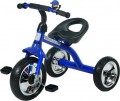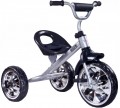Bicycle wheel diameter is traditionally indicated in ". The overall height of the bike directly depends on this parameter, so each age category has its own wheel size - in accordance with the height of the young cyclist. However, cars of the same type and age group may differ in wheel diameter; this is especially pronounced among two-wheeled bicycles. In such cases, it is worth considering the following point: larger wheels behave better on rough roads and allow you to coast for a long time, but they are reluctant to accelerate and require more effort on the pedals; small wheels - on the contrary, they spin without much effort, but they hold speed worse and are more sensitive to pits and potholes.
Tricycles predominantly have a wheel diameter of
10 ", balance bikes -
12 ". In two-wheeled models, there are sizes in
14,
16,
18 and
20 ". Larger diameter wheels are no longer used in children's, but in teenage bicycles (they are listed in our catalog in the section with older bikes).
—
Side wheels. Additional remote wheels mounted on both sides of the bike, usually in the area of \u200b\u200bthe rear axle. They are found exclusively in two-wheeled models (see "Type"). Their main purpose is to insure beginner cyclists who are not yet able to keep their balance: the bike does not fall on its side, even when it is stationary, and you can practice riding without fear of “accidents” and bruises. At the same time, the side wheels are usually made removable, so that when the child acquires the necessary skills to ride in the classic way, they can be removed.
—
Wings. Protective devices in the form of curved plates over the wheels of a bicycle; the name "shields" is also used. The main purpose of the wings is to protect the cyclist and the people around them from spray and dirt flying from the wheels while riding. This can be very useful, for example, in wet weather after rain.
—
Boot. A device for carrying various loads on a bicycle, located behind the saddle. In three-wheeled models (see "Type"), the boot is most often a plastic tray in which you can carry, for example, your baby's favorite toys. Two-wheelers usually use a platform with a clamp to secure the cargo being transported (although there are exceptions, up to a closed boot). It is worth noting that it is not recommended to use the boot for transporting passengers: it is unsafe and
...fraught with breakdowns.
— Basket on the steering wheel. Like the boot (see above), the handlebar basket is designed to carry various loads. It differs, in addition to placement, also in design: it is a rather deep container and can be equipped with a lid. It is found among both two- and three-wheeled vehicles (see "Type"); in some models, the baskets are made removable.
— Cup holder A stand that allows you to securely fasten a glass or a bottle with a drink — for example, milk for a baby or water for the parent himself. Naturally, such equipment is relevant for tricycles-wheelchairs.
— Bag for things. The presence in the design of the bicycle of its own handbag for transporting small items. The main difference from the boot and the basket on the steering wheel (see above) is the design: the bag is made of soft fabric and has a fastener. On two-wheeled models (see "Type") it is usually located on the handlebars, and on three-wheeled models it is on the parent handle (see above).
— Protective bumper. Safety bar around the saddle: the child can hold on to the bumper with his hands, in addition, this feature significantly reduces the risk of falling off the bike. It is installed exclusively on three-wheeled vehicles (see "Type").
— Seat belts. This item of equipment is installed on tricycles (see "Type"), designed for the smallest: seat belts securely fix the baby on the seat, preventing him from falling off the bike — which is especially important if an adult carries the car by the parent's handle (see above). ).
— Protective visor. A device placed above the baby's head and designed to protect from direct sunlight (to avoid heat strokes), and in some models also from rain. Fits exclusively on tricycles (see "Type"). The design of the protective visor can be different: a canopy, an umbrella, or even a folding hood like those found in pushchairs.
— Mirrors. Special mirrors mounted on the steering wheel and allowing the child to see what is happening behind him without turning his head. There can be one or two such mirrors (one mirror is standardly installed on the left). This feature provides additional driving safety and teaches the baby to constantly look “in mirrors” — this skill can be very useful in the future, when learning to ride an “adult” vehicle like a car or motorcycle.
— Signal / call. The presence of a bell or other sound signal supplied with the bike. It is found in all types of machines (see above), however, the specific purpose in some cases varies. So, in two-wheeled models, the signal is often made in the form of a bell and is intended to warn others who may otherwise not notice the cyclist in time. But in tricycles, a horn is usually installed, which can also play the role of additional entertainment for the child. Anyway, buying a model with a bell / signal will save you the hassle of finding and installing it yourself.
— Footboard. Additional support in the form of a folding "leg", used in two-wheeled bicycles. By opening such a support, you can put the bike upright, without leaning on surrounding objects such as a pole, fence, etc. And while riding, the footboard folds compactly and does not interfere with movement.
— Game panel. Used in tricycles (see "Type"). The main purpose of the game panel is to provide the baby with additional entertainment. But its execution is different: it can be toys placed directly on the steering wheel, buttons and switches with sound signals, arrows imitating the dashboard of a motorcycle, etc.
